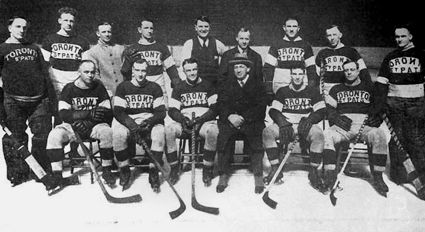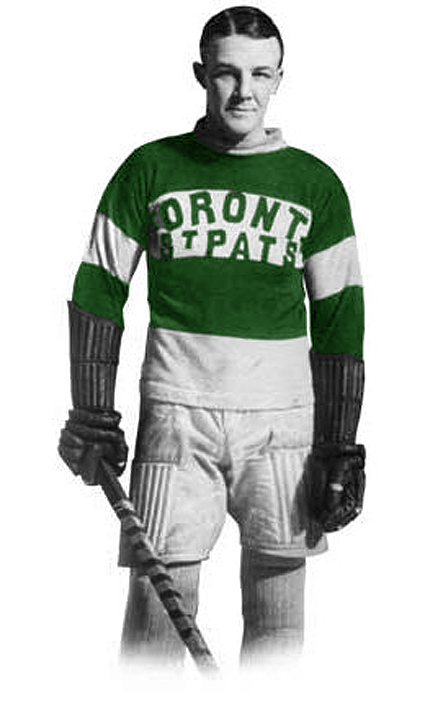Wednesday, December 22, 2010
1919-20 Toronto St. Patricks Reg Noble Jersey
It was on this date in 1919 that the Toronto St. Patricks joined the National Hockey League.
Two years earlier, as a result of a dispute with team owner Eddie Livingstone, with whom they did not get along, the other owners of teams from the National Hockey Association (NHA), minus Livingstone, announced they had formed a brand new league, the National Hockey League (NHL), which consisted of the Montreal Canadiens, the Montreal Wanderers, the Ottawa Senators and the Quebec Bulldogs. The new league also claimed to have retained the contracts of all of Livingstone's Toronto Blueshirts players after they had suspended Livingstone's franchise from the NHA!
With the Quebec Bulldogs suspending operations due to financial difficulties before the new NHL could even begin the 1917-18 season, the Arena Gardens were awarded a temporary NHL franchise, managed by Charlie Querrie, to make the fledgling NHL a four team league once again and assigned the Blueshirts players on a lease basis to the temporary Toronto franchise. To further complicate matters, many of the players signed contracts with both Livingstone and the Arena.
The Toronto club had no official nickname, but the "Arenas" were successful on the ice, winning the second half of the season schedule and earned the right to play Montreal for the championship, whom they defeated in a two games, total goals series 10-7, capturing the O'Brien Cup. Toronto then faced off against the Vancouver Millionaires of the PCHA and won the Stanley Cup by 3 games to 2, causing Livingstone to head to court to file suit for the revenue earned by "his" championship squad of players.
As a result of this lawsuit, the Arena Gardens formed a new company, the Toronto Arena Hockey Club Company, to own and run a hockey team, separate from the Arena Gardens business to protect the Arena business from Livingstone's lawsuits. The NHL then awarded a "new" franchise to the Hockey Club Company. This club was officially named the Toronto Arenas and, not surprisingly, was stocked with the same players from the 1918 championship club. When his players were once again not returned to him for the 1918-19 season, Livingstone sued the Arena Gardens.
Once again, the players were uncertain who would prevail in the courts, and covered their bases by signing contracts with both the Toronto Arena Hockey Club Company and Livingstone.
Livingstone did prevail in the courts sometimes, but not always. Two rulings in his favor of $20,000 and later $100,000 sent the Arena Gardens into bankruptcy. Despite the company's legal wranglings at the time, the arena would continue to operate for 77 years until closing in 1989.
When the Toronto Arenas did take to the ice in the 1918-19 season as Stanley Cup Champions, they did not play like it. Forced to sell most of their star players due to mounting legal bills, the Arenas record for the season was 5 wins and 13 losses, attendance was low and several players left the team. Finally, the team wrote to the league requesting that the season be ended when each of the three clubs had reached 18 games played and then officially withdrew from the league.
The Toronto Arenas franchise was then sold to the St. Patricks Hockey Club of Toronto, who ran the successful senior amateur St. Patricks team in the Ontario Hockey League.
The new owners renamed the club the Toronto St. Patricks and the $5,000 sale price was supposed to go to Livingstone to settle the purchase of his NHA club, for which he had once demanded $20,000 for after they had won the 1918 Stanley Cup. However, Livingstone never received the money, which many believe was kept by NHL president Frank Calder.
The club was incorporated on this date in 1919 and was forced to essentially start over as if they were a brand new club, as the Quebec franchise was being resumed after taking a two season break from operations, which necessitated the return to Quebec of many of the St. Patricks players who were on loan from the Bulldogs.
Still, they managed to finish 3rd in the first half of the schedule and 2nd in the second half. The following season they finished the first half in 2nd place, but improved to 1st place in the second half, which qualified them for the playoffs, where they were defeated by the Ottawa Senators.
The St. Patricks enjoyed their greatest triumph in 1921-22, placing second in the NHL, which gave them the opportunity to exact their revenge on Ottawa with a 5-4 two-game total-goal series to become champions of the NHL and advance to the Stanley Cup Finals against the Vancouver Millionaires of the PCHA, who they defeated three games to two in Toronto to capture their only Stanley Cup title while known as the St. Pats.
1921-22 Stanley Cup champion Toronto St. Pats
The St. Patricks slid down the standings to third the next two seasons, which caused them to miss out on the playoffs and cost them the chance to defend their championship.
They did climb back up to second in the 1924-25 season, but were defeated in the playoffs by the Montreal Canadiens 5 goals to 2.
Things took a down turn in 1925-26 when they dropped to 6th place with a 12-21-3 record. They began play as the St. Patricks for the 1926-27 season, when Querrie, having been sued by none other than Livingstone, was forced to sell the St. Patricks. He reached an agreement to sell the club to Conn Smythe, who renamed the club the Toronto Maple Leafs on February 17 of that season and constructed Maple Leaf Gardens in 1931.
Today's featured jersey is a 1919-20 Toronto St. Patricks Reg Noble jersey as worn during the St. Patricks first season in the National Hockey League. The St. Patricks would change to green sweaters with a white waist stripe, cuffs and collar for their second NHL season in 1920-21, but would return to this jersey for their Stanley Cup winning 1921-22 season.
Noble played 17 seasons, including eight with the Toronto franchise, five of those while they were named the St. Patricks. He was a member of three Stanley Cup winning teams and was inducted into the Hockey Hall of Fame in 1962.
Labels:
Noble Reg,
Toronto St. Patricks
Subscribe to:
Post Comments (Atom)













No comments:
Post a Comment
We welcome and encourage genuine comments and corrections from our readers. Please no spam. It will not be approved and never seen.